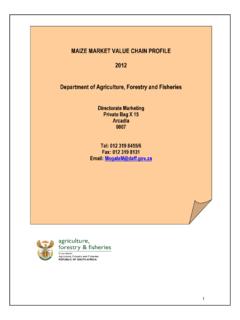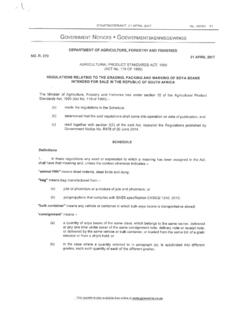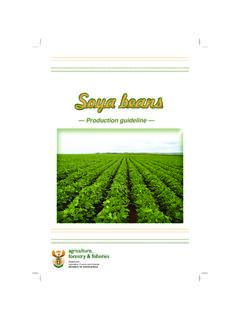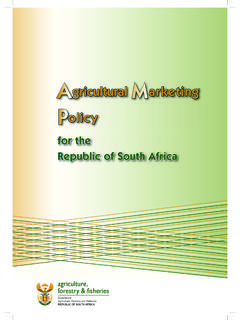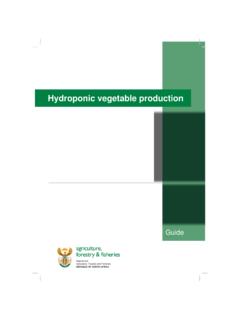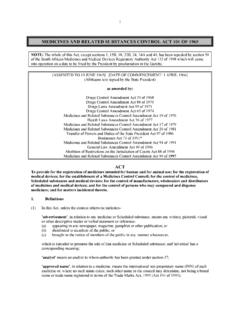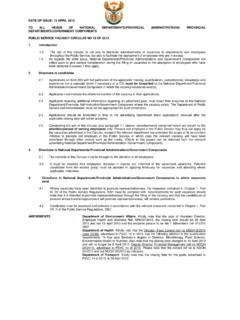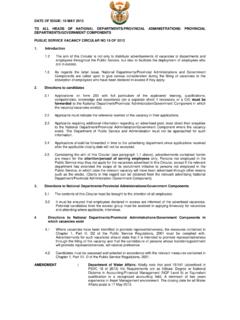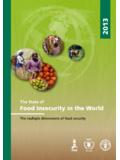Transcription of By Directorate Economic Services Production …
1 food Security By Directorate Economic Services Production Economics unit March 2011 Author: D. C. du Toit Assisted by: M. D. Ramonyai, P. A. Lubbe and V. Ntushelo i Preview This document draws heavily on research done and published by Aliber, Altman, Baiphethi, Hart, Jacobs and Matshe (Agrekon Vol. 48:4. December 2009) The document is organised in seven sections. The first section gives a background on food security in South Africa and the importance and commitment to address food security in the country; the second section provides an understanding of what the report aims to achieve; the third section provides a summary of empirical studies conducted on food security mostly focussing on issues relating to household food security; the fourth section outlines the role of the various departments of agriculture (national and provincial) in addressing household food security, the fifth section outlines the scope for further studies; and the sixth section concludes by identifying specific challenges relating to food security.
2 Ii Content 1. Background ..1 2. Objectives of the study ..2 3. Empirical studies on food security ..2 Defining food food security status in South Africa ..4 Household food security targets and Sources of information about household-level food security ..10 The role of agriculture ..11 The contribution of subsistence agriculture ..12 Should subsistence agriculture be supported?..13 4. The role of the Departments of Agriculture National and The Department of Agriculture, Forestry and The Provincial Departments of Agriculture and local 5. Scope for further 6. Challenges ..20 8. References ..22 1 Discussion notes on food security 1. Background The issue of food (in)security has been critical in many parts of the world including South Africa. The right to food is enshrined in international and national law. In South Africa, food security received much attention after 1994 when South Africa became a democratic country.
3 The right to access to sufficient food was embedded in Section 26 and 27 of the South African Constitutional law of 1996. The constitution indicates that every South African citizen has a right to sufficient food and water; and social security. In light of the above, the Department of Agriculture, Forestry and Fisheries was mandated to develop agricultural policies and support programmes to ensure that South African citizens are given agricultural opportunities that will enable them to meet their basic food needs. In the 2010/2011 financial year food security was reprioritised as one of the top priorities for South African government (State of Nation Address, 2010). This is in line with South Africa s millennium development goal which aims to halve the proportion of people who go hungry over the period 1990 and 2015 and to halve poverty and unemployment by 2014. The Department of Agriculture, Forestry and Fisheries (DAFF) s major role is, among others, to ensure that opportunities are created to encourage South African citizens to participate in agriculture and produce to reduce food insecurity in the country.
4 The department has since initiated a number of programmes that are meant to contribute positively to food security in the country. The food and Agricultural Organisation (FAO) report for 2008 indicates that international estimates of people experiencing chronic hunger increased dramatically over the period 1990 to 2007. According to the report the increase in numbers of chronically hungry people was due to increased food prices worldwide as a result of lower Production of staple food around the world such as cereals. The price of oil also contributed to the high food prices in 2 many parts of the world. Political instability, wars, and lack of agricultural inputs in many parts of African countries, played a role in food insecurity as arable land lay fallow. 2. Objectives of the study The objective of the study is to review literature on food security studies in South Africa and identify gaps that were not covered and recommend future research on how the agricultural sector can contribute significantly to food security in the country.
5 3. Empirical studies on food security Defining food security food security is a broad term, which is defined in different ways by a number of organisations around the world. The basic definition of food security is that it refers to the ability of individuals to obtain sufficient food on a day-to-day basis. Internationally food security is defined as the ability of people to secure adequate food . More especially it has been defined by researchers as the access by all people at all times to enough food for an active healthy life (Anderson 1990). According to the World food Summit organised in Rome in 1996, food security exists when all people, at all times, have physical and Economic access to sufficient, safe, nutritious food to meet their dietary needs and food preferences for an active life. The Directorate : food Security within the Department of Agriculture, Forestry and Fisheries, food and Agriculture Organisation of the United Nations (FAO), as well as the Centre for Poverty, Employment and Growth (CPEG) of the Human Sciences Research Council (HSRC) acknowledged that food security has three dimensions namely food availability, food access and food use.
6 food availability in the definition implies that a country must have sufficient quantities of food available on a consistent basis at both national and household level. food access implies the ability of a nation and its households to acquire sufficient food on a sustainable basis. food use refers to the appropriate use based on knowledge of basic nutrition and care, as well as adequate water and sanitation. 3 Literature by Anderson (1990) sees it fit to distinguish between food security at national and household level. This distinction is crucial since the approach to assess food security in those levels are not the same. food security at national level refers to the condition whereby the nation is able to manufacture, import, retain and sustain food needed to support its population with minimum per capita nutritional standards. At community level food security is defined as the condition whereby the residents in a community can obtain safe, culturally accepted, nutritionally adequate diets through a sustainable system that maximises community self reliance.
7 At household level food security refers to the availability of food in one s home which one has access to. In this case, a household is regarded as food secure when the members of the family do not live in hunger or fear of starvation. The concept of food (in)security is closely linked with the poverty in country. The two concepts are interrelated and to some extent have an influence on one another. In any food security discourse, it is also essential to highlight in a nutshell the plight of poverty in the country. Poverty refers to the condition of not having the means to afford basic human needs such as clean water, nutrition, health care, education, clothing and shelter. United Nation Development Programme (UNDP) report of 2006 pointed out that food insecurity is closely linked to poverty, income and unemployment. The report reveals that poverty and unemployment have strong relationship with food insecurity and in most cases food insecurity manifest in multiple deprivations.
8 food insecurity begins with the loss of employment, which in turns leads to a significant degradation in living standard. Living in poverty creates additional challenges which limit the ability for people to search for employment and that contribute to a long term unemployment trap. Lack of income due to unemployment, contribute to food insecurity and leads to socials exclusion problems. The FAO report (2008) basically echoed the findings in the UNDP report. The report suggested that food insecurity creates a destructive cycle of improvement. Hart (2009) pointed out that most definition of food security include the phrase at all times and as such does not distinguish between different durations and intensities of food 4 insecurity . Furthermore, food insecurity has a temporal as well as an intensity dimension. Temporal dimension can be chronically (long term or persistent), transitory (referring to short periods of extreme scarcity of food availability and access) as well as seasonal or cyclical.
9 The intensity dimension on the other hand refers to the magnitude of the food gap. It is also important to have a good understanding of the concepts vulnerability and food insecurity . Vulnerability has an external and internal dimension, and food insecurity has a temporal and intensity dimension (Hart, 2009). An understanding of these distinctions and dimensions associated with the concept of food (in)security are necessary for policy development and appropriate interventions to address food security issues. food security status in South Africa South Africa is largely deemed a food secure nation producing enough staple foods or having the capacity to import food , if needed in order to meet the basic nutritional requirements of its population (FAO 2008). Hart et al (2009) supported the argument that South Africa seems to be food secure at national level but the same cannot be said about households in rural areas. The national food self-sufficiency index (Figure 1) clearly illustrates that South Africa is food self-sufficient or nearly self-sufficient in almost all the major food product, with the ability to import shortages when necessary.
10 5 Figure 1: National food self-sufficiency index Source: Department of Agriculture, Forestry and Fisheries Figure 2, 3 and 4 demonstrates the food security situation at household level. 6 0102030405060708090200220032004200520062 0072008 PercentageNever went hungrySeldom went hungrySometimes went hungryOften went hungryAlways went hungry Figure 2: Trends of households that went hunger over the period 2002 to 2008 Source: General household survey (2009) Statistics South Africa 0102030405060708090200220032004200520062 0072008 PercentageNever went hungrySeldom went hungrySometimes went hungryOften went hungryAlways went hungry Figure 3: Trends of household food adequacy for South Africa over the period 2002-2008 Source: General household survey (2009) Statistics South Africa 7 0102030405060708090100W CECNCFSKZNNWGPMPLPP ercentageFood access severly indadequateFood access inadequateFood access adequate Figure 4: Trends of household food adequacy by province over the period 2002 to 2008 Source.
